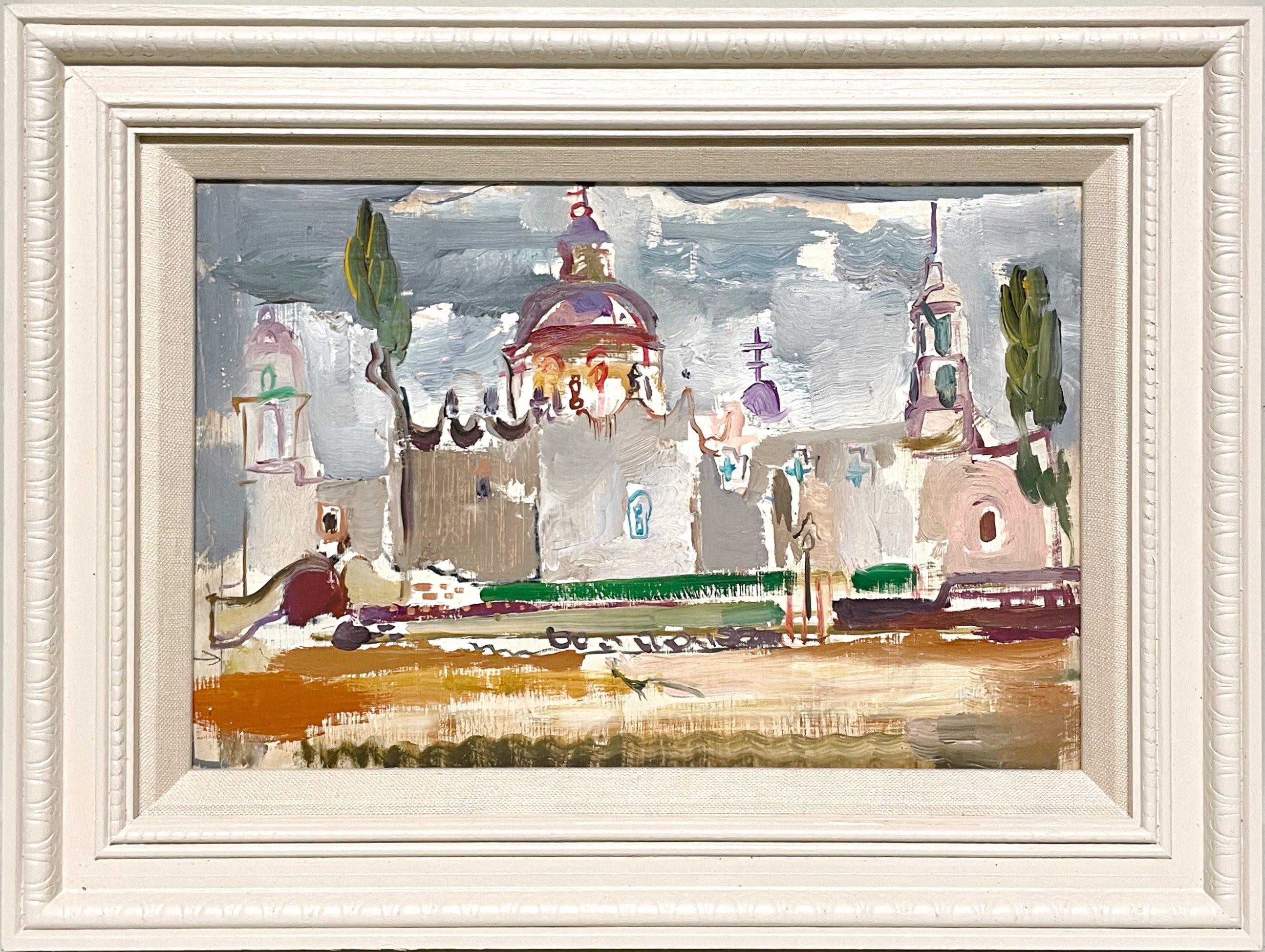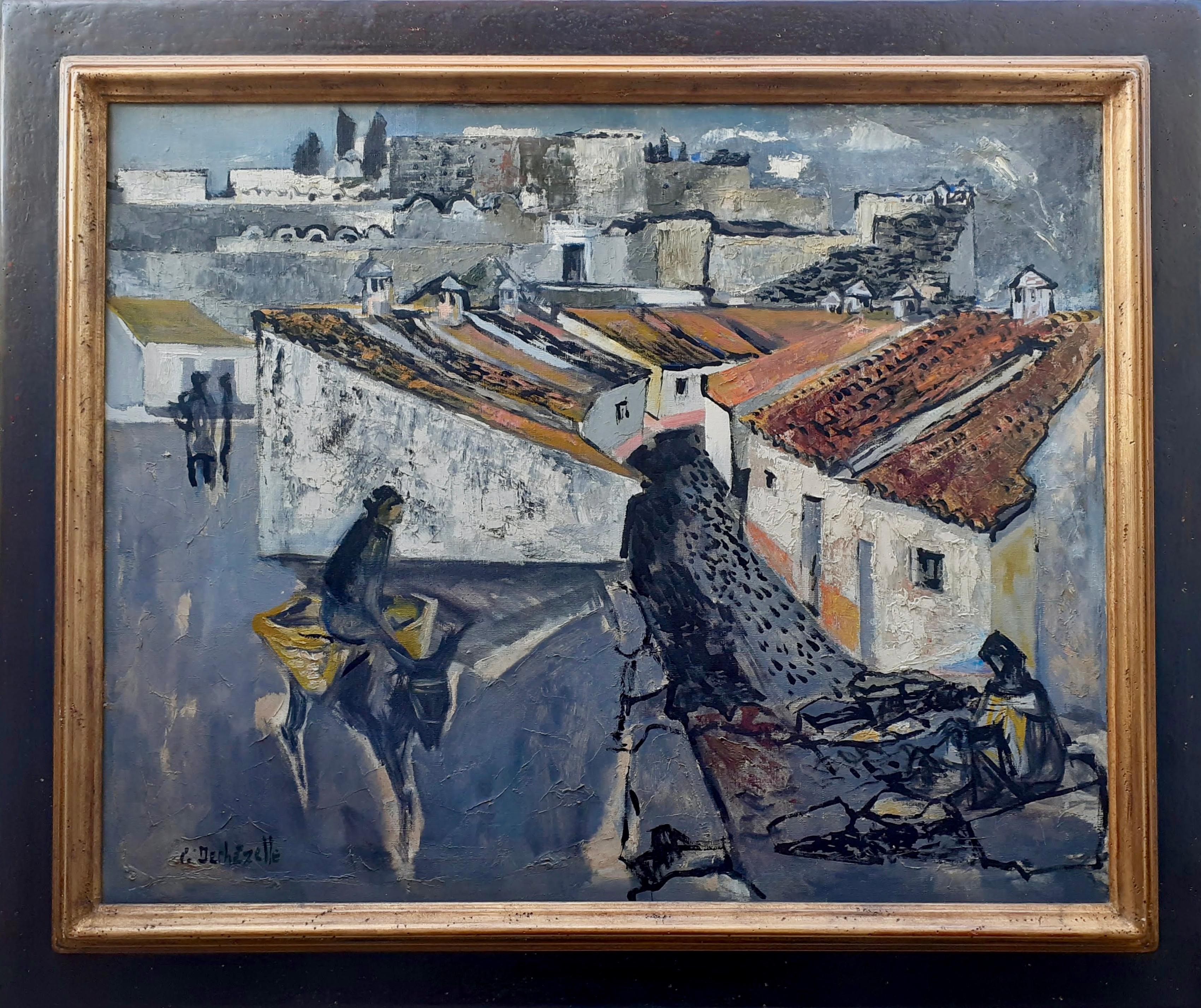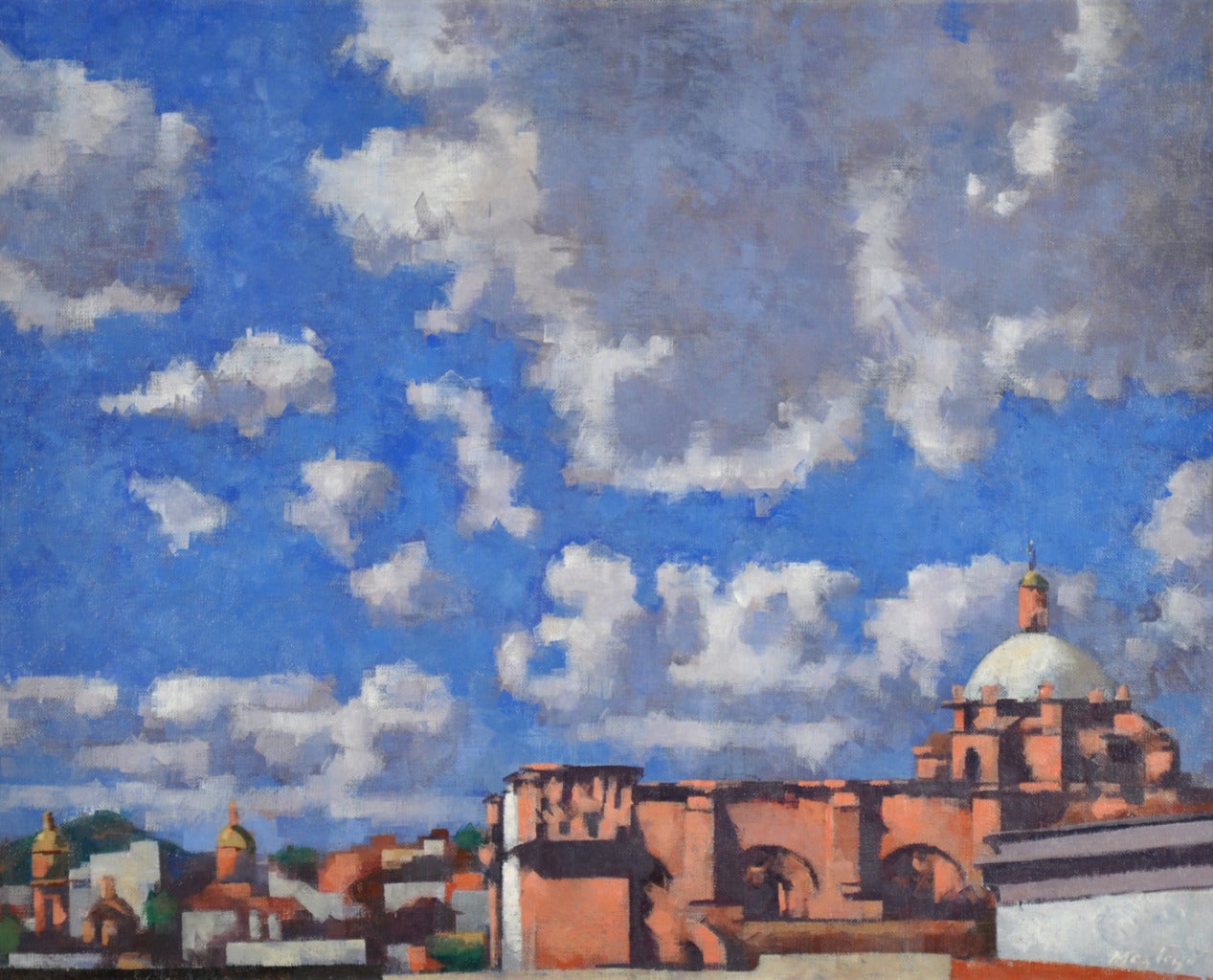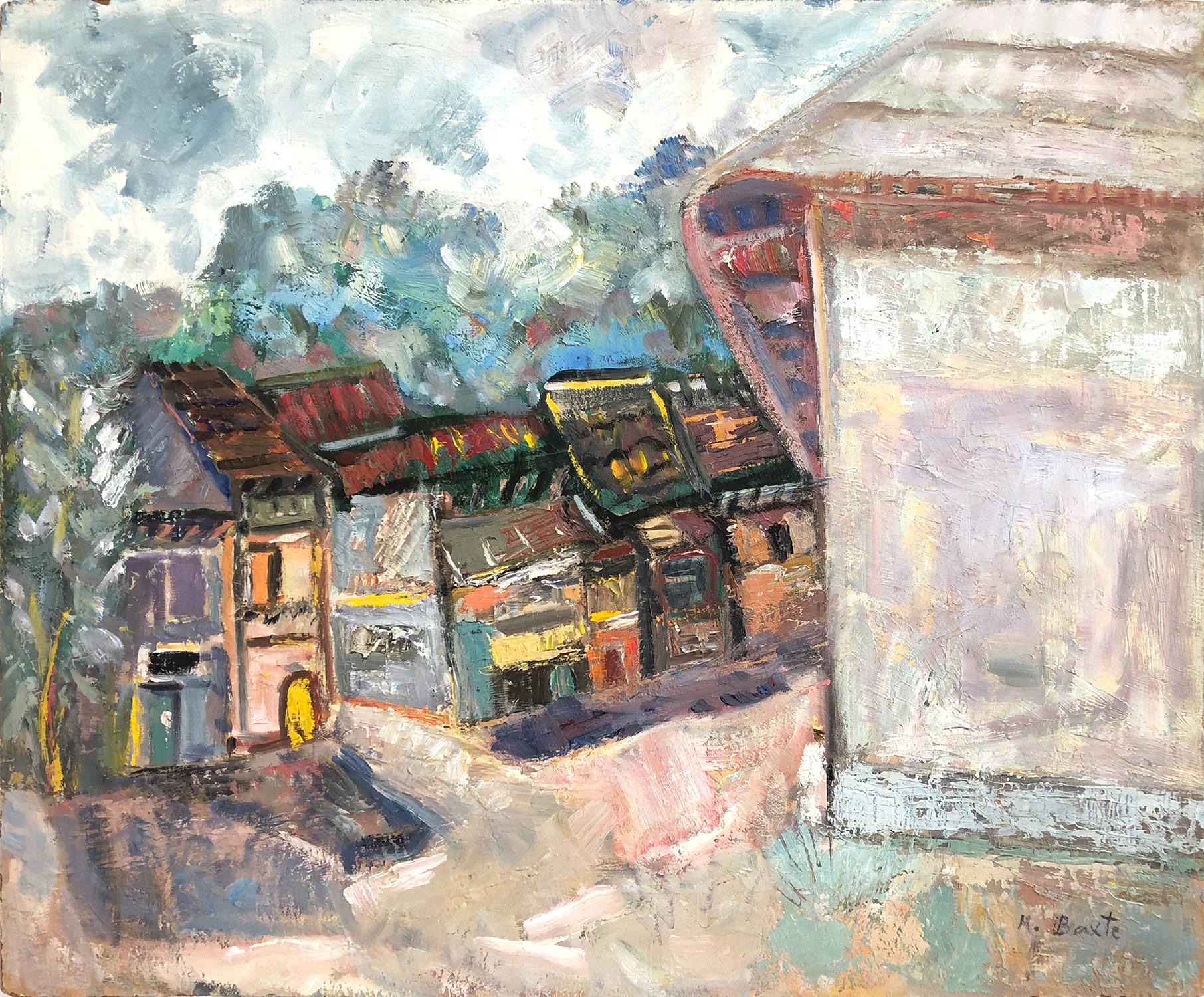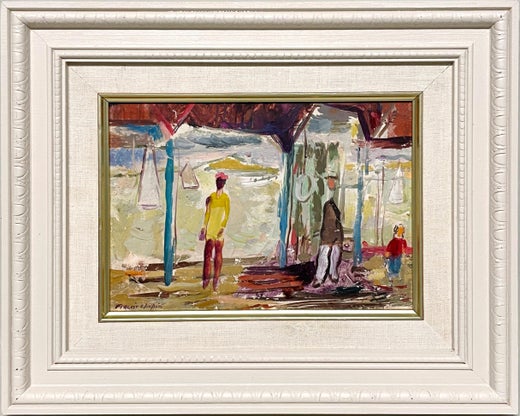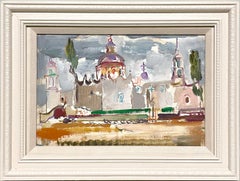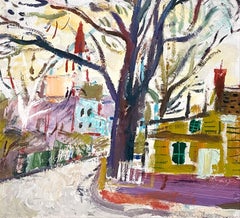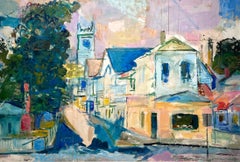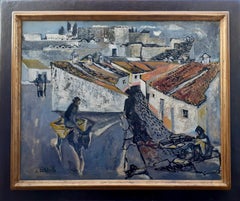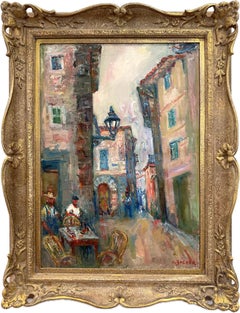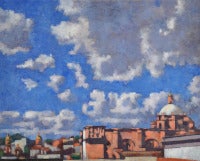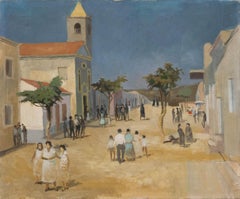Items Similar to Early Mexican City Scene by Chicago Artist Francis Chapin, San Miguel de Allende
Want more images or videos?
Request additional images or videos from the seller
1 of 10
Francis ChapinEarly Mexican City Scene by Chicago Artist Francis Chapin, San Miguel de Allendeca. 1940
ca. 1940
$950
£726.33
€836.58
CA$1,331.24
A$1,486.21
CHF 778.75
MX$18,192.62
NOK 9,890.13
SEK 9,325.13
DKK 6,243.49
Shipping
Retrieving quote...The 1stDibs Promise:
Authenticity Guarantee,
Money-Back Guarantee,
24-Hour Cancellation
About the Item
A charming, vibrant, early Mexican city street scene by famed Chicago Modern artist Francis Chapin (Am. 1899-1965). Titled "Old Church, San Miguel de Allende (Spanish Plaza)", the painting is oil on canvas, dates ca. 1940 and is signed "Francis Chapin" lower right with a hand-written titled inscription on the reverse. Artwork size: 9” x 16"; Framed size: 9 1/2” x 16 1/2”. Provenance: Estate of the artist. A painting of wonderful color with great visual appeal!
Francis Chapin, affectionately called the “Dean of Chicago Painters” by his colleagues, was one of the city’s most popular and celebrated painters in his day. Born at the dawn of the 20th Century in Bristolville, Ohio, Chapin graduated from Washington & Jefferson College near Pittsburgh, Pennsylvania before enrolling at the Art Institute of Chicago in 1922. He would set down deep roots at the Art Institute of Chicago, exhibiting there over 31 times between 1926 and 1951. In 1927 Chapin won the prestigious Bryan Lathrop Fellowship from the Art Institute – a prize that funded the artist’s yearlong study trip to Europe. Upon his return to the United States, Chapin decided to remain in Chicago, noting the freedom Chicago artists have in developing independently of the pressure to conform to pre-existing molds (as was experienced by artists in New York, for example). Chapin became a popular instructor at the Art Institute, teaching there from 1929 to 1947 and at the Art Institute’s summer art school in Saugatuck, Michigan (now called Oxbow) between 1934 – 1938 (he was the director of the school from 1941-1945). Chapin’s contemporaries among Chicago’s artists included such luminaries as Ivan Le Lorraine Albright, Edgar Miller, William S. Schwartz and Aaron Bohrod among others.
A prolific painter, Chapin produced numerous works while traveling in Mexico, France, Spain, Saugatuck and Martha’s Vineyard, where he frequently spent summers and taught at the Old Sculpin Gallery there. Chapin was best recognized for his dynamic and vibrant images of Chicago during the 1930s and 40s. Chapin was a resident of the Old Town neighborhood where he lived and kept his studio on Menomonee Street for many years. Described as a “colorful figure, nearly 6 feet 6 inches tall, and thin, and usually wearing tweeds”, it is easy to imagine Chapin at work observing the busy street life of the city.
In addition to his many exhibitions at the Art Institute of Chicago, Chapin’s work was shown during his lifetime at such institutions as the Pennsylvania Academy of Fine Arts, Philadelphia; the Corcoran Gallery, Washington, D.C.; the National Academy of Design, New York; the Museum of Modern Art, New York; the Whitney Museum of American Art, New York and the Carnegie Institute, Pittsburgh, among others. Francis Chapin’s paintings are represented in the collections the Art Institute of Chicago; the Friedman Collection, Chicago; the Butler Institute of American Art, Youngstown; the Denver Art Museum; the Everson Museum of Art, Syracuse; the Norton Museum of Art, West Palm Beach; the Telfair Museum of Art, Savannah and the Brooklyn Museum of Art, among others.
- Creator:Francis Chapin (1899-1965, American)
- Creation Year:ca. 1940
- Dimensions:Height: 9.5 in (24.13 cm)Width: 16.5 in (41.91 cm)Depth: 2 in (5.08 cm)
- Medium:
- Movement & Style:
- Period:
- Condition:Fine original condition with narrow stained oak slat frame. See photos.
- Gallery Location:Chicago, IL
- Reference Number:Seller: #191801stDibs: LU2591216005102
Francis Chapin
Francis Chapin, affectionately called the “Dean of Chicago Painters” by his colleagues, was one of the city’s most popular and celebrated painters in his day. Born at the dawn of the 20th Century in Bristolville, Ohio, Chapin graduated from Washington & Jefferson College near Pittsburgh, Pennsylvania before enrolling at the Art Institute of Chicago in 1922. He would set down deep roots at the Art Institute of Chicago, exhibiting there over 31 times between 1926 and 1951. In 1927 Chapin won the prestigious Bryan Lathrop Fellowship from the Art Institute – a prize that funded the artist’s yearlong study trip to Europe. Upon his return to the United States, Chapin decided to remain in Chicago, noting the freedom Chicago artists have in developing independently of the pressure to conform to pre-existing molds (as was experienced by artists in New York, for example). Chapin became a popular instructor at the Art Institute, teaching there from 1929 to 1947 and at the Art Institute’s summer art school in Saugatuck, Michigan (now called Oxbow) between 1934 – 1938 (he was the director of the school from 1941-1945). A prolific painter, Chapin produced numerous works while traveling in Mexico, France, Spain, Saugatuck and Martha’s Vineyard, where he frequently spent summers and taught at the Old Sculpin Gallery there. Chapin was best recognized for his dynamic and vibrant images of Chicago during the 1930s and 40s. Chapin was a resident of the Old Town neighborhood where he lived and kept his studio on Menomonee Street for many years. Described as a “colorful figure, nearly 6 feet 6 inches tall, and thin, and usually wearing tweeds”, it is easy to imagine Chapin at work observing the busy street life of the city. In addition to his many exhibitions at the Art Institute of Chicago, Chapin’s work was shown during his lifetime at such institutions as the Pennsylvania Academy of Fine Arts, Philadelphia; the Corcoran Gallery, Washington, D.C.; the National Academy of Design, New York; the Museum of Modern Art, New York; the Whitney Museum of American Art, New York and the Carnegie Institute, Pittsburgh, among others. Francis Chapin’s paintings are represented in the collections the Art Institute of Chicago; the Friedman Collection, Chicago; the Butler Institute of American Art, Youngstown; the Denver Art Museum; the Everson Museum of Art, Syracuse; the Norton Museum of Art, West Palm Beach; the Telfair Museum of Art, Savannah and the Brooklyn Museum of Art, among others.
About the Seller
5.0
Recognized Seller
These prestigious sellers are industry leaders and represent the highest echelon for item quality and design.
Established in 2000
1stDibs seller since 2023
71 sales on 1stDibs
Typical response time: 3 hours
- ShippingRetrieving quote...Shipping from: Chicago, IL
- Return Policy
Authenticity Guarantee
In the unlikely event there’s an issue with an item’s authenticity, contact us within 1 year for a full refund. DetailsMoney-Back Guarantee
If your item is not as described, is damaged in transit, or does not arrive, contact us within 7 days for a full refund. Details24-Hour Cancellation
You have a 24-hour grace period in which to reconsider your purchase, with no questions asked.Vetted Professional Sellers
Our world-class sellers must adhere to strict standards for service and quality, maintaining the integrity of our listings.Price-Match Guarantee
If you find that a seller listed the same item for a lower price elsewhere, we’ll match it.Trusted Global Delivery
Our best-in-class carrier network provides specialized shipping options worldwide, including custom delivery.More From This Seller
View AllEarly Mexican City Scene by Chicago Artist Francis Chapin, San Miguel de Allende
By Francis Chapin
Located in Chicago, IL
A charming, vibrant, early Mexican city street scene by famed Chicago Modern artist Francis Chapin (Am. 1899-1965). Depicting a quiet, picturesque view of the rooftops and cathedral...
Category
1940s American Modern Landscape Paintings
Materials
Oil, Masonite
MOMA Exhibited Watercolor by Chicago Artist Francis Chapin, "Tourists in Taxco"
By Francis Chapin
Located in Chicago, IL
A charming, vibrant, early Mexican city street scene by famed Chicago Modern artist Francis Chapin (Am. 1899-1965). Titled "Tourists in Taxco", the watercolor was exhibited at the M...
Category
1930s American Modern Landscape Drawings and Watercolors
Materials
Paper, Watercolor
A Vibrant, 1930s American Modern Painting, Chicago City Street Scene, Old Town
By Francis Chapin
Located in Chicago, IL
A Vibrant, 1930s Chicago City Street Scene of the Old Town Neighborhood by Notable Chicago Modern Artist, Francis Chapin (Am. 1899-1965). Depicting a colorful, blustery, autumn view...
Category
1930s American Modern Landscape Paintings
Materials
Masonite, Oil
A Charming 1950s Martha's Vineyard Street Scene Painting by Francis Chapin
By Francis Chapin
Located in Chicago, IL
A large & delightful oil on Masonite, ca. 1950s, Martha's Vineyard street scene painting by artist Francis Chapin. Image size: 24" x 36". Framed size: 27" x 37". In a painted woo...
Category
1950s American Modern Landscape Paintings
Materials
Masonite, Oil
A Dynamic Mid-Century Modern Manhattan Scene, New York City by Francis Chapin
By Francis Chapin
Located in Chicago, IL
A Large, Dynamic 1950s Mid-Century Modern Watercolor of Lower Manhattan, New York City by Noted Chicago Artist, Francis Chapin (Am. 1899-1965). The image is watercolor, pastel and c...
Category
Mid-20th Century American Modern Landscape Paintings
Materials
Watercolor, Archival Paper, Charcoal, Pastel
A Charming 1940s Watercolor of Mexico w/ Cathedral and Rooftops by Rudolph Pen
Located in Chicago, IL
A Charming 1940s Watercolor of Mexico with Cathedral and Rooftops by Noted Chicago Artist, Rudolph T. Pen. Most likely completed during the artist's trip to Mexico in 1944 after rec...
Category
1940s American Modern Landscape Drawings and Watercolors
Materials
Paper, Watercolor, Gouache
You May Also Like
Large mid century modern abstracted cityscape painting southern landscape
By Claude Dechezelle
Located in Norwich, GB
A major, mid century modern work by French artist Claude Dechezelle (1928-2003). Having studied with the art deco painter and designer Jean Dupas at ...
Category
Mid-20th Century French School Landscape Paintings
Materials
Canvas, Oil
"Village in Mexico" Post-Impressionist Town Scene Oil Painting on Canvas Framed
By Jacques Zucker
Located in New York, NY
This painting depicts an village scene of people gathering about to have lunch in a Mexican town street. The fun details are what make this painting so attractive and desirable; ther...
Category
20th Century Post-Impressionist Landscape Paintings
Materials
Canvas, Oil
San Agustin - Zacatecas (From Azotea of Hotel)
By Loren Mozley
Located in Dallas, TX
signed "Mozley" at lower right
Category
Late 20th Century American Modern Paintings
Materials
Canvas, Oil, Panel
Mid 20th Century Oil - South American Townscape
Located in Corsham, GB
A bustling South American townscape with figures leaving Church. Unsigned. On canvas on stretchers.
Category
20th Century Landscape Paintings
Materials
Oil
$461 Sale Price
20% Off
"Colorful Mexican Village Scene" Expressionistic Oil Painting on Masonite
By Michael Baxte
Located in New York, NY
A strong modernist oil painting depicted Circa 1960 by Russian painter Michael Baxte. Mostly known for his abstracted figures on canvas or street scenes, this piece is a wonderful representation of his bold still life paintings, with expressive use of color, shape, and form. Later in his career, Baxte explores Expressionism, infusing both European and North American stylistic trends. This piece is from later in his career, but we can feel this underlying style throughout.
Art measures 18 x 21.75 inches
Michael Posner Baxte was born in 1890 in the small town of Staroselje Belarus, Russia. For the first half of the 19th century it was a center of the Chabad movement of Hasidic Jews, but this group was gone by the middle of the 19th century. By the time the Baxte family immigrated to the United States at the beginning of the 20th century, the Jewish population numbered only on the hundreds. The native language of the Baxte family was Yiddish. It is likely that the death of Michael Baxte’s father triggered the family’s immigration. Three older brothers arrived in New York between 1903 and 1905. Michael and his mother, Rebecca, arrived in 1907. By 1910 Michael, his mother, and brother, Joseph, were living in New Orleans and may have spent some time on a Louisiana plantation. Around 1912, Michael Baxte returned to Europe to study the violin. In 1914 he, his mother, and Joseph moved to New York City.
Meanwhile, in Algeria, a talented young woman painter, Violette Mege, was making history. Since for the first time, a woman won the prestigious Beaux Art competition in Algeria. At first, the awards committee denied her the prize but, with French government intervention, Mege eventually prevailed. She won again 3 years later and, in 1916, used the scholarship to visit the United States of America. When Violette came to New York, she met Baxte, who was, by then, an accomplished violinist, teacher, and composer. Baxte’s compositions were performed at the Tokyo Imperial Theater, and in 1922 he was listed in the American Jewish Yearbook as one of the prominent members of the American Jewish community. As a music teacher he encouraged individual expression. Baxte stated, “No pupil should ever be forced into imitation of the teacher. Art is a personal experience, and the teacher’s truest aim must be to awaken this light of personality through the patient light of science.”
By 1920 Michael Baxte and Violette Mege were living together in Manhattan. Although they claimed to be living as husband and wife, it seems that their marriage did not become official until 1928. On their “unofficial” honeymoon around 1917, in Algiers, Baxte confided to her his ambition to paint. There and later in New Mexico where the wonderful steeped sunlight approximates the coloring of Algiers, she taught him his heart’s desire. He never had any other teacher. She never had any other pupil. For ten years she devoted all her time, energy, and ambition to teaching, encouraging, inspiring him. Then in 1928, their mutual strivings were rewarded, as his works were being chosen as one of the two winners in the Dudensing National Competition for American Painters. Out of 150 artists from across the country participated in the Dudensing, and Michael Posner Baxte and, Robert Fawcett, were the winners.
In his 1924 naturalization application, he indicated that he was sometimes known as “Michael Posner Baxte.” One of the witnesses to his application was Bernard Karfiol, a Jewish American artist. That’s when Michael may...
Category
1960s Expressionist Landscape Paintings
Materials
Oil, Masonite
Looking South. NYC urban landscape Part Mexico city landscape melded together
By Stephen Basso
Located in Brooklyn, NY
This is an experimental work by the artist combining two different city landscapes. It was created after the artist's return to New York after visiting Mexico
Category
1990s American Modern Landscape Paintings
Materials
Canvas, Oil
More Ways To Browse
Vintage Chicago Street Sign
Ivan Summers
Bronze Horse Painted
Farm Workers
Used Bakers Scale
1893 Chicago Worlds Fair
19th Century British Marine Painting
Field Of Wild Flowers Paintings
Newport Rhode Island Paintings
Rochelle Landscape
Buoy Painting
Maine Plein Air Paintings
Michael Lynch Painting
Paris Rooftops
Paul Arnold
S Lucas Painting
Spencer House
W Hughes
